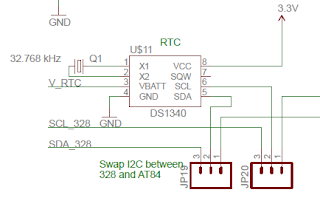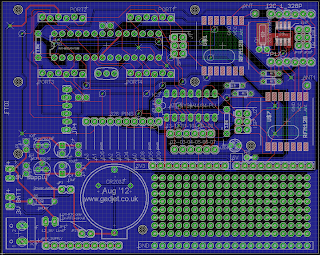Eagle files can be found here, they are version 2 with the power supply fixed and an added higher power 5V regulator.
So far I've only tried the ATMega 328p and it's peripherals, the ATtiny84 can wait until next weekend.
Firstly I added all the resistors, they need to be quite small resistor, physically that is, as I only used a 5mm lead pitch package. I then added the voltage regulators so I could check that power appeared correctly at all the places it should do and at the right level.
This is where I spotted my first error, originally I'd planned to feed the 3.3V regulator from the output of the 5V regulator but then for some strange reason I changed it so both regulator inputs were tied together, unfortunately this meant that when the USB to serial (FTDI) was connected it wouldn't supply the 3.3V regulator and therefore the processor wouldn't be powered.
I cut the track from the supply to the input of the 3.3V regulator and wired it to the output of the 5V regulator. this meant that the FTDI 5V was fed into the 3.3V regulator and supplied the processor.
One of the first things I tried when I got the boards was to plug in the GLCD from Jeelabs as I use this quite a lot, luckily it fit perfectly and it even works.
Today the RTC chip arrived with a clock crystal and was soldered in place, not as difficult as I thought it would be.
Added a CR2032, loaded the RTC sketch and used my RTC time setting app for the PC to set the time and it worked fine.
So far so good.....

















